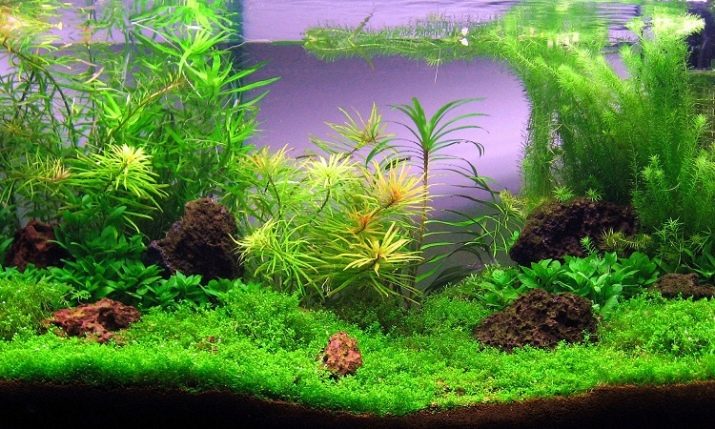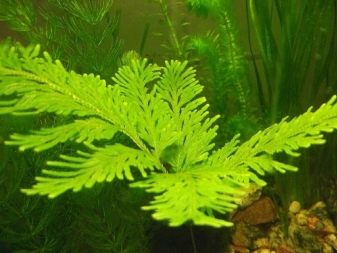A home aquarium that has no vegetation looks boring and imperfect. To correct the situation, representatives of the flora will help. Today, there are a large number of plant species for artificial ecosystems, which are characterized by unpretentiousness and extreme endurance.

Advantages and disadvantages
Provided that the plants or fast-growing algae are selected correctly, the aquarium gives the impression of a magical underwater world that can calm, and also set up for positive emotions. Flora helps maintain water balance within an artificial ecosystem and makes its conditions as close to natural as possible.
In addition to the fact that the vegetable aqua corner contributes to the normal life of the reservoir inhabitants, it has the following advantages:
- emits oxygen, and also provides natural filtration;
- promotes the utilization of vital products of living things, as well as the purification of water;
- with its foliage it absorbs mineral elements that provide the vitamins of freshwater;
- serves as food for fish, provided that they lack what the person gives;
- Vegetation in the aquarium is a place for laying eggs, as well as a shelter option for fish.

There are practically no shortcomings in aquatic plants that do not need special care. However, a person should remember that, like other representatives of the flora, they need optimal conditions for growth, which must be created. The unpretentiousness of these plant species is expressed in the absence of the need for bright lighting, the supply of carbon dioxide, as well as their special fertilizing fertilizers.

Types and their description
The list with the names of unpretentious aquarium plants is quite extensive. You can choose the flora for the foreground, background of the aquarium and its central part. Some ground cover specimens are sensitive to light, however, most of them are shade-loving, including red, green, and other specimens.
Below are considered the most unpretentious representatives of aquarium vegetation.

Seaweed
Many aquarists do not like the fact that the walls of their artificial ecosystem are attacked by algae, which they have to deal with. But there are those whose presence makes the underwater world more interesting and mysterious, for example, the cladophore.
This type of filamentous algae is able to form whole colonies, which in aggregate have the appearance of a green ball. This plant is to the liking of small fish, since they get nutrients from it. A cladophore needs clean, clear water with neutral or medium hardness.
She loves coolness, at high temperature she is able to lose shape.

Javanese moss
This decorative representative of the flora is considered one of the most popular. He can tolerate insufficient lighting, various indicators of acidity and ambient temperature. It has the ability to exist not only in water, but also on land, as well as being attached to objects with a fishing line.
Javanese moss can die from excessive water pollution, in which organic elements settle on its foliage, which stops photosynthesis.

Floating vegetation
Representatives of this subgroup have the opportunity to exist on the surface of the water. Their roots hang in the water column, due to which they absorb the substances necessary for the existence. Floating plants are able to bloom and at this time decorate the ecosystem with a unique view. The most interesting representatives include duckweed and floating richia.


Ferns (Indian and Thai)
The pterygoid Thai specimen is characterized by beautiful relief leaves, which have an external resemblance to willow. The growth of such a fern is usually slow, but after some time in the aquarium you can see thickets of bright green color. A similar bush can be placed near walls, corners, in the background.
Indian fern has openwork dissected light green foliage. Thanks to the good development of the rhizome, this type of fern is able to turn into a bush.
This vegetation requires a nutrient substrate 4 cm thick.


Hornwort
The plant has the ability to live in both tropical and cold climates. Hornwort is a plant that floats on the water surface or grows by attaching to the decor. This type of vegetation increases its size with high speed, thereby providing protection to the inhabitants of the aquarium.

Flowering
Representatives of this group of green plants can have different sizes, shapes, colors. Most often in an artificial ecosystem you can find such floral vegetation:
- hygrophil - this hardy species of plants is characterized by large sizes, therefore it can be used to decorate the tank;
- lemongrass - in bright light this plant acquires a bright pink color, it looks a little out of the water column, therefore it gives the artificial pond a special mystery.
In order to revitalize the central part of the aquarium, you can use the sprawling vegetation in the form of Amazonian echinodorus, anubias. Swamp Ludwig and Indian Rotala can also decorate the aquarium system with its brightness.Each of the above representatives of the flora is characterized by an interesting shape, color and appearance.
Using them, you can realize your fantasies about the original design of an artificial ecosystem.


How to choose?
In order to choose aquarium vegetation, novice specialists should remember that it must meet a number of characteristics.
- Hardy plant must adapt to living in water with a variety of parameters. The stiffness coefficient in this case can be from 4 to 20. Representatives of the flora also do not present requirements for water temperature, which is very comfortable for the aquarist who knows little about this business.
- Attitude to lighting or, more precisely, to its lack. Many aquariums are equipped with lamps with low light intensity, but this does not affect the growth and development of plants.
- Resistance to abrupt change of conditions. If you do not pay attention to your aquarium for a long time, then it will change acidity. After cleaning, you can notice that there is a jump in the pH level indicator, this can only withstand unpretentious plants.
- No need for ongoing care activities. Plants of this type are able to survive, even if they are shaded for a long time, without mineral fertilizers, dense plantations.
- Pest resistance. A hardy plant will die very slowly, so if you take the necessary measures, you can bring it back to life.

Unpretentious aquarium vegetation should be selected, taking into account conditions for its future maintenance.
- Dimensions of the aquarium. In a tank of small volume, you should not plant a plant that can grow to enormous size, as in the future this may become an obstacle to the normal life of the fish.
- Types of living things, who live in an artificial ecosystem.
- Illumination and temperature conditions of the aquarium.
- Water parameters.

How to plant and contain?
According to most novice experts, aquarium vegetation is a lot of trouble. However, this judgment does not apply to unpretentious underwater greenery. In order for green spaces (just like fish) to feel great, it is worth creating certain conditions for them. The optimal microclimate of the artificial ecosystem is achieved by selecting the appropriate illumination, substrate, water indicators and types of fertilizing.
To plant such representatives of the flora in the ground, you do not need to do anything special - enough elementary planting measures. To do this, only the root system without a stem is immersed in the soil, which subsequently takes root. To revitalize the central part of the aquarium, it is worth planting sprawling large bushes, for example, Amazonian echinodorus, anubias or wallisneria. It is better if the soil under such plants is fed, greens can live in shading, in water with any acidity.
In the foreground, it is better to plant carpet vegetation or small bushes.

Greenery in an artificial home ecosystem looks very beautiful, but it can be diluted with red bushes. This option will add originality and brightness to the tank. Many colorful representatives of plants live in medium or bright light, but are finicky to the acidity of the water. In the background, it is worth planting tall unpretentious plants that cover the equipment of the aquarium in the form of filters, heaters.
For for vegetation in the aquarium to please the human eye for a long time, it requires both macro- and microelements. Nitrates, phosphates and sulfates enter the aquarium water naturally. If there are too many of these substances, this can cause the algae to bloom.Underwater representatives of the flora need a little copper, manganese, zinc, iron, since an excess can lead to negative consequences.

Breeding rules
Aquarium vegetation not only makes the fish tank uniquely beautiful, but also emphasizes the brightness of its inhabitants. With the content of underwater greenery and its independent breeding, each aquarist has the opportunity to create unique interiors of an artificial ecosystem by combining different types of plants.

The methods of reproduction of representatives of the underwater flora are different.
- Vegetative. In this case, a young plant is formed from the vegetative parts of the body of the maternal representative.
- Using child elements. It is customary to call a daughter plant that which was formed from an adnexal type kidney that arose on the mother's organ. After the young representatives have their own leaflets and roots, they can be separated from the main one, otherwise it will disappear by itself and float to the water surface. The strengthening of the daughter of young animals occurs in the substrate.
- Layering. This type of young plant is able to form on creeping shoots. It can occur both in the leaf sinus, and in the form of a whip from several internodes. With the help of layering, representatives of the flora, which float on the water surface, also multiply.
- Cuttings. These are parts of shoots that are inherent in plants with long stems. A handle that, using a sharp object, is separated from the base, must have 3 nodes. It should be planted in a substrate. In this way, vegetation that floats in the water column has the ability to multiply.
- With the help of the genitals. This method of procreation refers to flowering plants, which ultimately give seeds.

Beginners who bought their first aquarium and launched the inhabitants into it, can see the incompleteness in the design of the tank. The emptiness and lifelessness of the species can be corrected by planting unpretentious aquarium vegetation.
Such representatives of the flora are considered a real salvation for an inexperienced aquarist, as they do not need complex care measures and special indicators of the aquatic environment, soil. Plants that feel good in low light and varying temperatures are available in a wide variety, and are quite inexpensive.

You can find out how to care for an aquarium with living plants by watching the video below.










